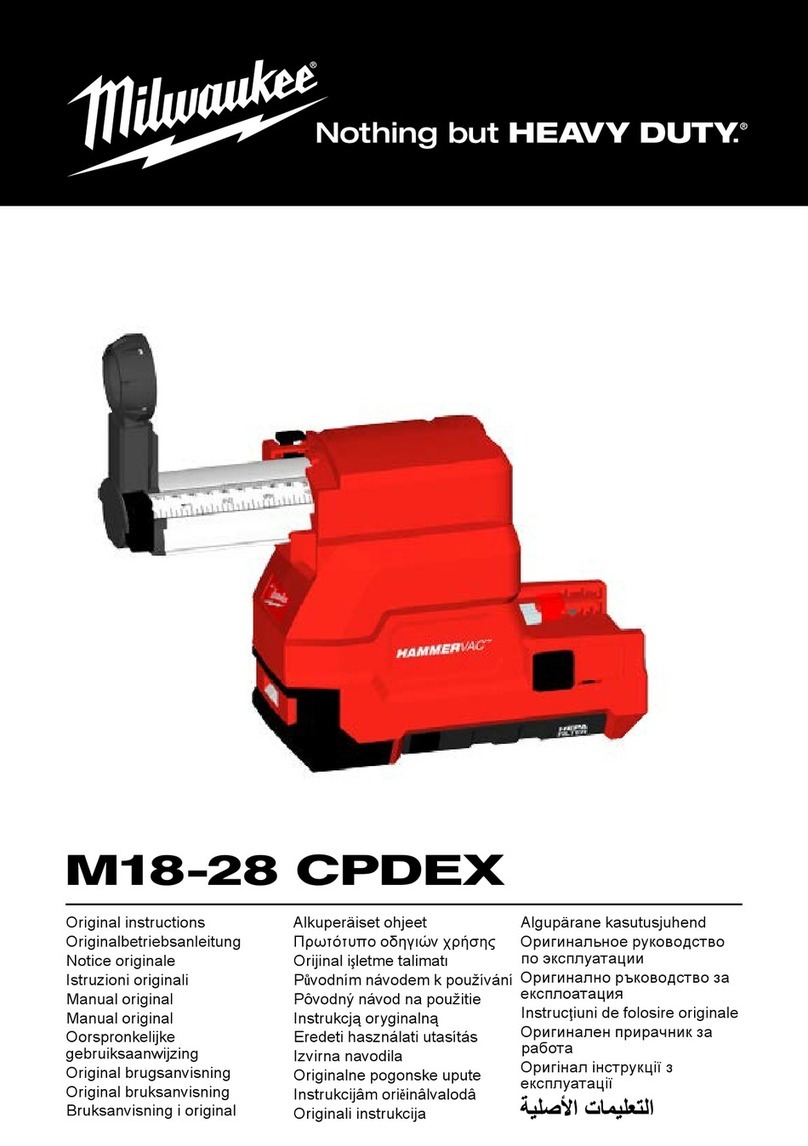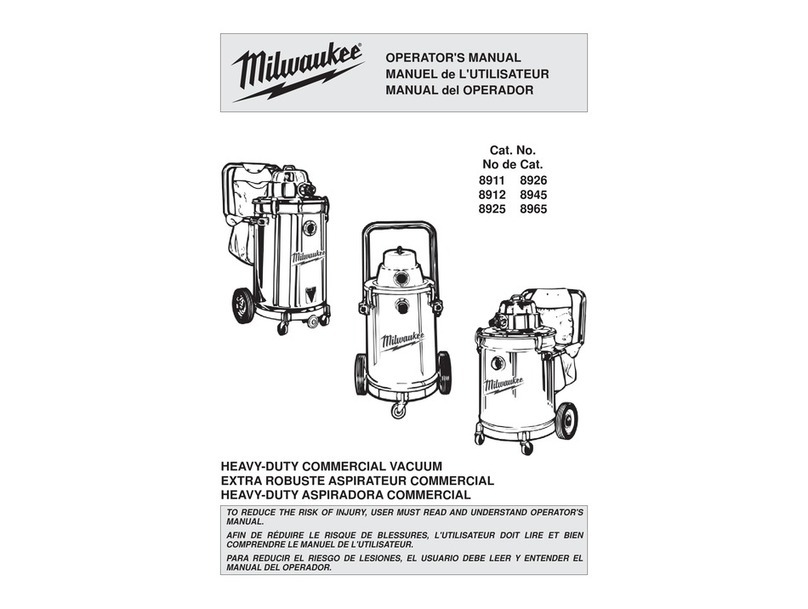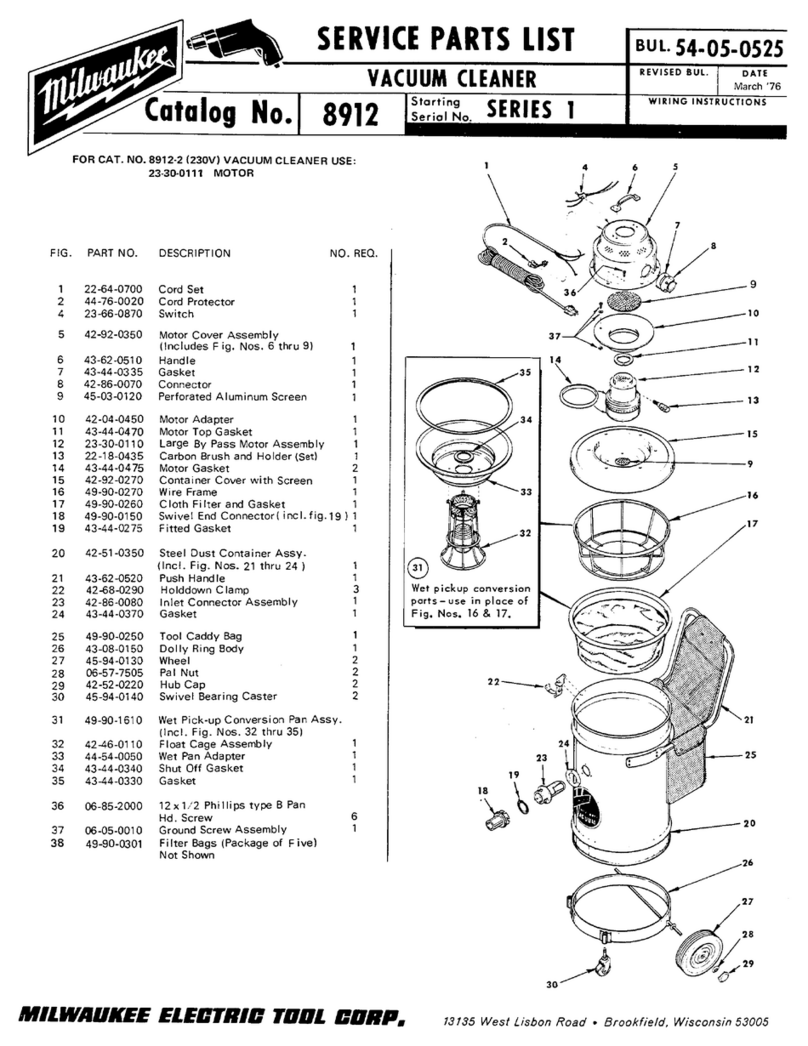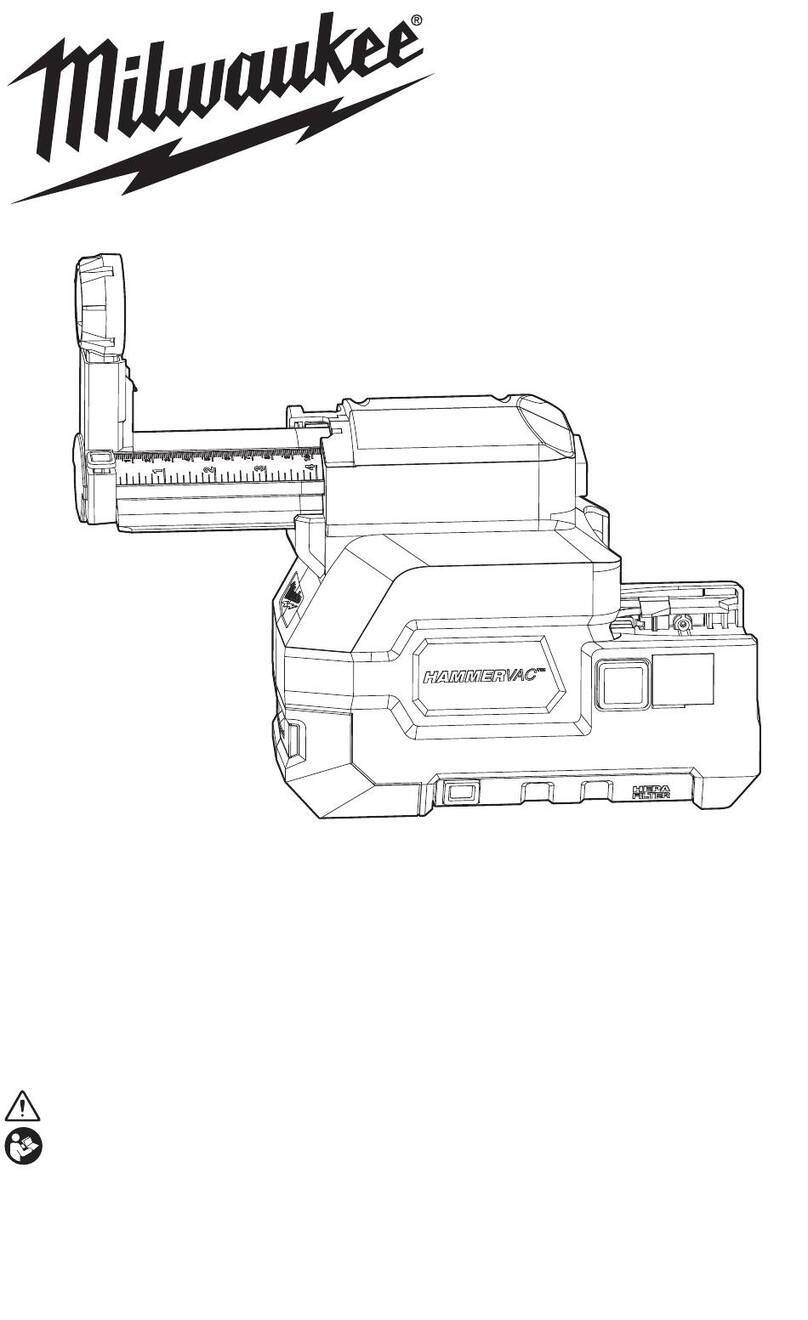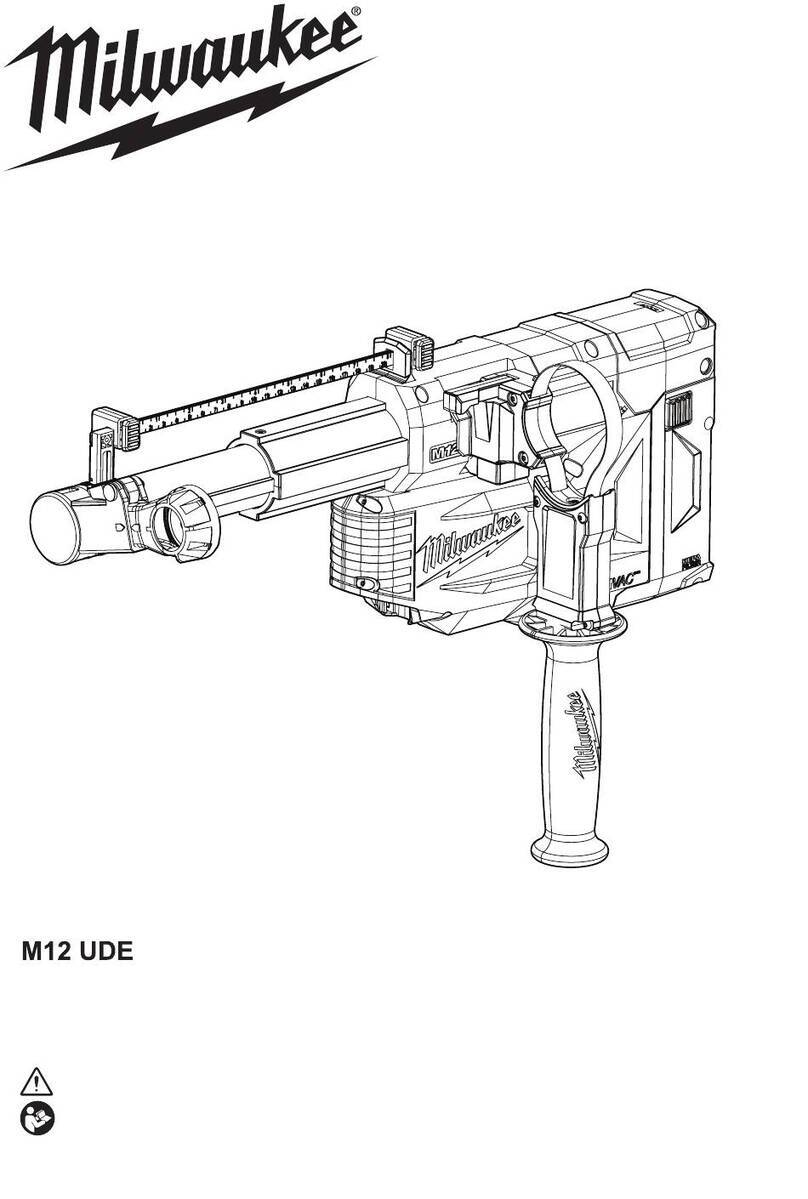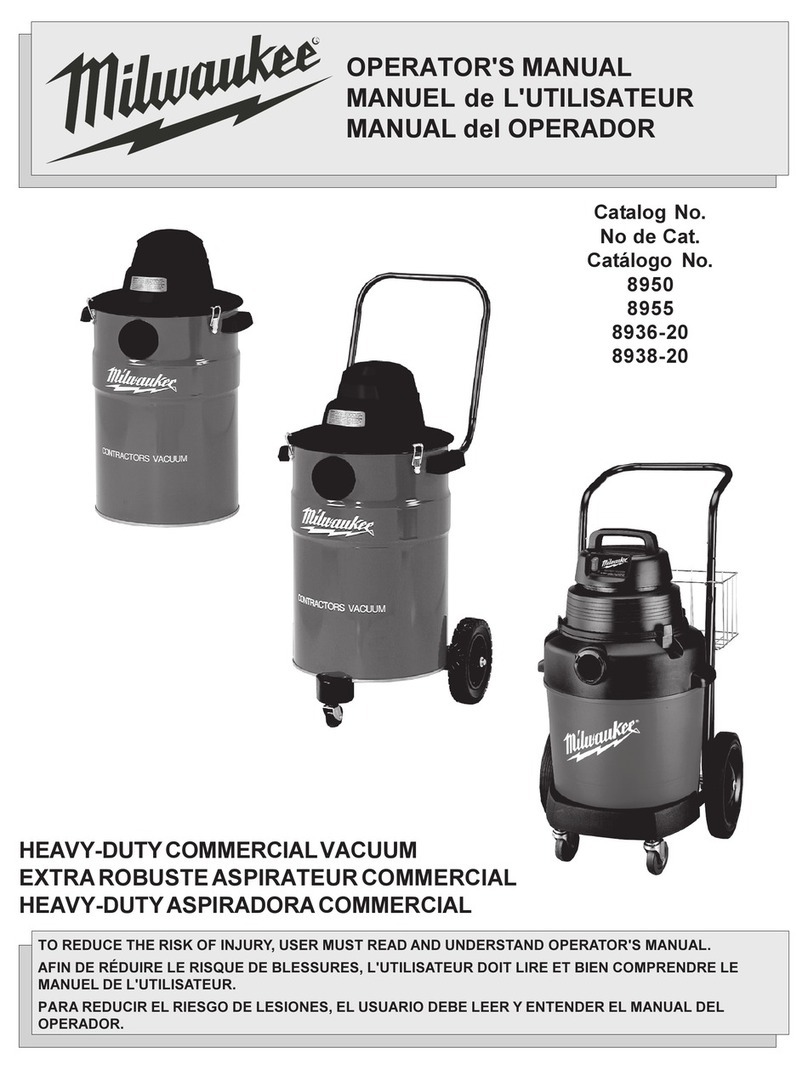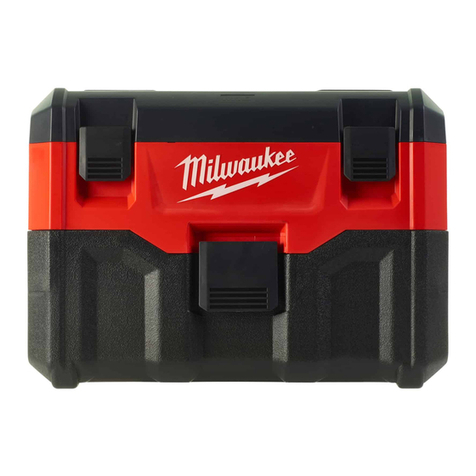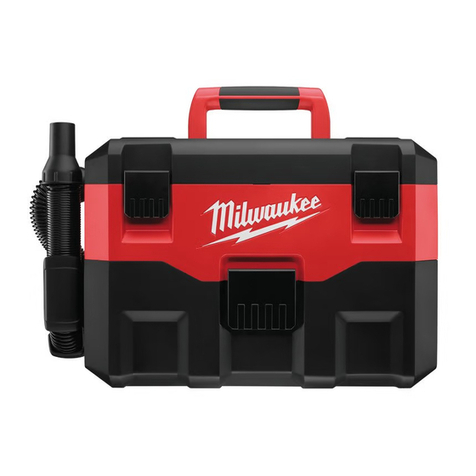
Starting and Stopping Vacuum
To turn on the vacuum, push the switch to the ON
(I) position.
To turn off the vacuum, push the switch to the OFF
(O) position.
Wet Pick-Up Operation
1. Remove ALL dirt and debris found in the tank.
Install the filter.
2.
3. Turn on the vacuum and begin pick-up.
Turn off the vacuum immediately upon complet-
ing a wet pick-up job or when tank is full and
ready to be emptied.
4. Remove the battery pack.
5. Raise the hose to drain any excess liquid into
the tank.
6.
7.
Remove motor housing and pour liquid waste
into a suitable drain.
Clean the interior of the tank, the filter, and pick-
up accessories periodically, more often when
usedto pick up wet,sticky materials. Usewarm,
soapy water.
Automatic suction Shut-Off
When picking up liquids, an internal floatrises until
it seats itself against a seal at the intake of the mo-
tor, shutting off suction. When this happens, the
motorwilldevelop a higher than normal pitchnoise
andthe suction is drastically reduced. If this occurs,
turn off the vacuum immediately. Failure to turn off
unit after float rises and shuts off suction will result
inextensivedamage to the motor.To continue use,
empty the liquid waste from the tank.
NOTE: If the vacuum is accidentally tipped over, it
could lose suction. Turn off the vacuum and return
it to an upright position. The float will return to its
normal position.
Storage
Before storing your vacuum, empty and clean the
tank, filter, and accessories. Remove the battery
pack.
WARNING To reduce the
risk of fire and injury, do not use to pick up
flammable or combustible materials.
WARNINGTo reduce the
risk of injury, wear safety goggles or glasses
with side shields. Remove the battery pack
before changing accessories, making adjust-
ments, and removing the motor housing.
WARNINGTo reduce the
risk of personal injury and damage, never
immerse your tool, battery pack or charger
in liquid or allow a liquid to flow inside them.
WARNINGTo reduce the
risk of injury, always unplug the charger and
remove the battery pack from the charger
or tool before performing any maintenance.
Never disassemble the tool, battery pack or
charger. Contact a MILWAUKEE service facil-
ity for ALL repairs.
To obtain a catalog, con-tact your local distributor
or a service center listed on the back cover of
this operator’s manual.
WARNINGAlways remove
battery pack before changing or removing
accessories. Only use accessories specifi-
cally recommended for this tool. Others may
be hazardous.
Maintaining Tool
Keep your tool, battery pack and charger in good
repairbyadoptingaregular maintenance program.
After six months to one year, depending on use,
return the tool, battery pack and charger to a
MILWAUKEE service facility for:
• Lubrication
• Mechanicalinspectionand cleaning (gears, spin-
dles, bearings, housing, etc.)
• Electrical inspection (battery pack, charger,
motor)
• Testing to assure proper mechanical and
electrical operation
If the tool does not start or operate at full power
witha fully charged battery pack, clean the contacts
on the battery pack. If the tool still does not work
properly, return the tool, charger and battery pack,
to a MILWAUKEE service facility for repairs.
Cleaning
Clean dust and debris from charger and tool
vents. Keep tool handles clean, dry and free of oil
or grease. Use only mild soap and a damp cloth
to clean the tool, battery pack and charger since
certaincleaningagentsandsolventsareharmful to
plastics and other insulated parts. Some of these
include gasoline, turpentine, lacquer thinner, paint
thinner, chlorinated cleaning solvents, ammonia
and household detergents containing ammonia.
Never use flammable or combustible solvents
around tools.
Repairs
For repairs, return the tool, battery pack and
charger to the nearest service center listed on the
back cover of this operator's manual.
OPERATION MAINTENANCE
ACCESSORIES
WORK AREA SAFETY
•Keep work area clean and well lit. Cluttered or
dark areas invite accidents.
•Vacuums have motors and other parts that can
produce sparks during normal use. Do not use
within 30 feet of areas where explosive materials
may be present (such as gasoline pumps and places
where liquids like paint thinners, cleaners, solvents,
etc. are stored).
•Do not use in the presence of explosive dust,
liquids or vapors.
•Do not use where oxygen or anesthetics are
used.
•Do not allow to be used as a toy. Close attention
is necessary when used by or near children.
•Use extra care when using on stairs.
ELECTRICAL SAFETY
•Wear electrically insulated footwear, such as
rubber boots, when vacuuming wet material.
•Do not handle battery pack or vacuum with wet
hands.
•Store indoors. Do not expose to rain.
PERSONAL SAFETY
•STAY ALERT. Watch what you are doing and use
common sense. Do not use vacuum when you are
tired, distracted or under the inuence of drugs,
alcohol or medication causing diminished control.
•The operation of a vacuum can result in foreign
objects being blown into eyes, which can result in
eye damage. Always wear safety goggles or glasses
with side shields when operating vacuum.
•Wear a face or dust mask when working in dust
situations. Dust particles can harm your lungs.
•Avoid accidental starting. Ensure the switch is
in the o-position before inserting battery pack.
Inserting battery pack in vacuum that has the switch
on invites accidents.
•Do not overreach. Keep proper footing and bal-
ance at all times. This enables better control of the
vacuum in unexpected situations.
•Never stand on vacuum or use as a step stool.
•Keep hair, loose clothing, ngers, and all parts
of body away from openings and moving parts.
•Use only as described in this manual. Use only
manufacturer’s recommended attachments.
USE AND CARE
•Do not use without tank and/or lter properly
installed.
•Do not use to pick up ammable or combustible
liquids such as gasoline or use in areas where they
may be present.
•Do not pick up anything that is burning or smok-
ing such as cigarettes, matches, or hot ashes.
•Do not pick up soot, cement, plaster or drywall
dust without lter in place. These are very ne
particles that may aect the performance of the
motor or be exhausted back into the air.
•This product is suitable for collection of silica
dust when used in accordance with these in-
structions. To reduce the risk of health hazards
from other vapors or dust, do not vacuum
carcinogenic, toxic or hazardous materials
such as asbestos, arsenic, barium, beryllium, lead,
pesticides or other health endangered materials.
•
WARNING
Some dust created by
power sanding, sawing,
grinding, drilling, and other construction activities
contains chemicals known to cause cancer, birth
defects or other reproductive harm. Some examples
of these chemicals are:
•lead from lead-based paint
•crystalline silica from bricks and cement and other
masonry products, and
•arsenicand chromiumfrom chemically-treatedlumber.
Your risk from these exposures varies, depending
on how often you do this type of work. To reduce
your exposure to these chemicals: work in a well
ventilated area, and work with approved safety
equipment, such as those dust masks that are spe-
cially designed to lter out microscopic particles.
•Use special care when emptying heavily loaded
tanks.
•To avoid spontaneous combustion, empty tank
after each use.
•Do not leave vacuum unattended when battery
pack is installed. Remove battery pack when not
in use and before servicing.
•Do not put any object into openings. Do not use
with any opening blocked; keep free of dust, lint,
hair, and anything else that may reduce air ow.
•Maintain vacuum. Check for misalignment or
binding of moving parts, breakage of parts and
any other condition that may aect the vacuum's
operation. If damaged, have the vacuum repaired
before use. Many accidents are caused by poorly
maintained tools.
•Maintain labels and nameplates. These carry
important information. If unreadable or missing,
contact a MILWAUKEE service facility for a free
replacement.
BATTERY PACK USE AND CARE
•Use vacuum only with specically designated
battery packs. Use of any other battery packs may
create a risk of injury and re.
•Turn o all controls before removing battery pack.
•Before using the battery pack or charger read
the operator’s manuals, and any labels on the
battery pack, charger and vacuum.
•Recharge only with the charger specied by the
manufacturer. A charger that is suitable for one type
of battery pack may create a risk of re when used
with another battery pack.
IMPORTANT SAFETY INSTRUCTIONS
WARNING
WHEN
PRECAUTIONS
USING AN
SHOULD
EL
AL
ECT
WA
RI
YS
CAL
BE V
FOLLOWED
ACUUM,
, BASI
INCLUD
C
-
INGTHEFOLLOWING:READALLINSTRUCTIONSBEFOREUSINGVACUUM.
FORHOUSEHOLDUSEONLY.BEFOREUSING THE VACUUM,READTHISOP-
ERATOR’SMANUAL,BATTERYPACKANDCHARGEROPERATOR’SMANUALS,
AND ALL LABELS ON THE VACUUM, BATTERY PACK, AND CHARGER.
